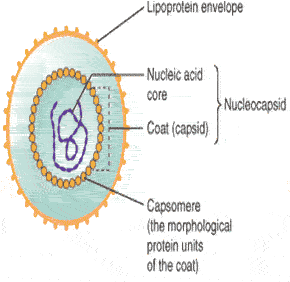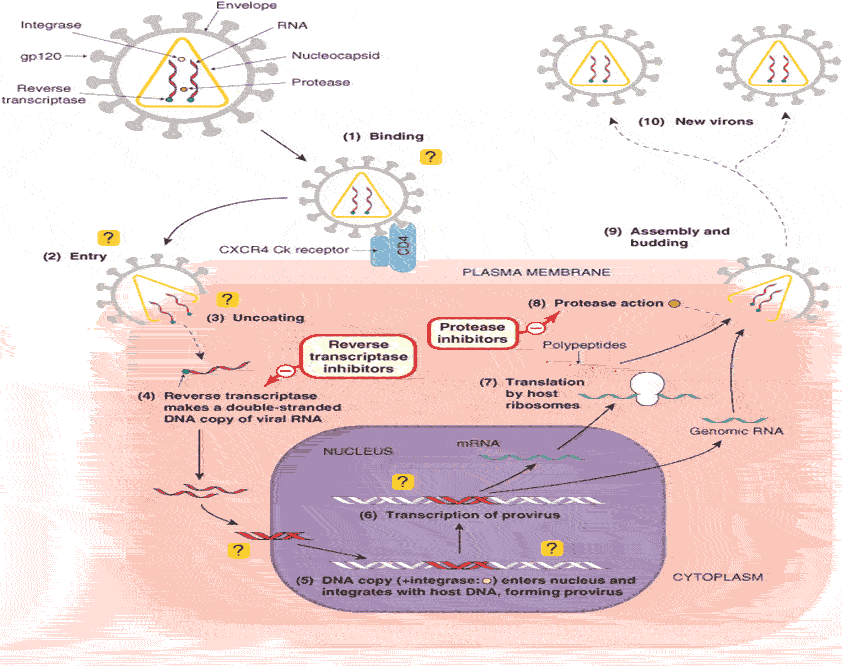Sample Content
GPAT Study Material
GPAT Study Material - Pharmacology: Antiviral Drugs
Viruses are unique organisms. They are the smallest of all self-replicating organisms, able to pass through filters that retain the smallest bacteria. The simplest form of viruses contain a small amount of DNA or RNA surrounded by an uncomplicated protein coat. More than 200 viruses have been identified as capable of producing disease. Acute viruses, such as the common cold, have a rapid onset and quick recovery. Chronic viral infections, such as acquired immunodeficiency syndrome (AIDS), have recurrent episodes of exacerbations (increases in severity of symptoms of the disease) and remissions (periods of partial or complete disappearance of the signs and symptoms).
Background Information about Viruses: An Outline Of Virus Structure: Viruses are small (usually in the range 20-30 nm) infective agents that are incapable of reproduction outside their host cells. The free-living (e.g. outside its host) virus particle is termed a virion, and consists of segments of nucleic acid (either RNA or DNA) enclosed in a protein coat comprised of symmetrical repeating structural units and called a capsid. The viral coat, together with the nucleic acid core, is termed the nucleocapsid. Some viruses have, in addition, a further external lipoprotein envelope, which may be decorated with antigenic viral glycoproteins or phospholipids acquired from its host when the nucleo-capsid buds through the membranes of the infected cell. Certain viruses also contain enzymes that initiate their replication in the host cell Viruses are generally characterized either as DNA or RNA viruses depending on the nature of their nucleic acid content. These two broad categories are conventionally subdivided into some six subclasses, which classify viruses According to whether they contain single- or double-stranded nucleic acids and how this functions during replication. Viruses can infect virtually all living organisms. Humans are no exception, and such infections are common.
DNA viruses: poxviruses (smallpox), herpesviruses (chickenpox, shingles, cold sores, glandular fever), adenoviruses (sore throat, conjunctivitis) and papillomaviruses (warts).
RNA viruses: orthomyxoviruses (influenza), paramyxoviruses (measles, mumps, respiratory tract infections), rubella virus (German measles), rhabdoviruses (rabies), picornaviruses (colds, meningitis, poliomyelitis), retroviruses (acquired immunodeficiency syndrome [AIDS], T-cell leukaemia), arenaviruses (meningitis, Lassa fever), hepadnaviruses (serum hepatitis) and arboviruses (arthropod-borne encephalitis and various febrile illnesses, e.g. yellow fever).

Classification of Antiviral Drugs:
(A): Nonanti Retroviral Drugs:
- 1.Agents involving inhibition of stages of viral replication: Amantidine.
- 2.Agents interfering with viral nucleic acid replication-(DNA-Polymerase Inhibitors): Acyclovir, Idoxuridine, Vidarabine, cytarabine, Ribaverine, Trifluorothymidine.
- 3.Agents affecting Translationa of Ribosomes Methisazone.
(B): Anti Retroviral Drugs-(anti-HIV Agents):
- 1.Nucleoside Reverse-Transcriptase Inhibitors:Azidothymidine,Didanosine, Zalcitabine, Stavudine, Lamivudine, Abacavir.
- 2.Non-nucleoside Reverse Transcriptase Inhibitors: Nevirapine, Efavirenz, Delaveridine.
- 3.HIV-Protease Inhibitors: Saquinavir, Indinavir, Ritonavir, Amprenavir, Nelfinavir.
Immunomodulators:Immunogolubulins, Interferons, Monoclonal Anitbodies.
New Potential Anti-viral Therapy: HIV-Entry inhibitors, Chemokine Receptor inhibitors, inhibition of gp41-Fusion Activity & Integrase Inhibitors
( Novel approaches in clinical trials).

Become a member of GPATTutor.com and access all the sections!
If you are a new user Register Now Existing User Login Now
